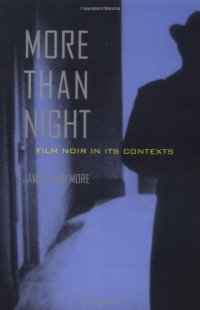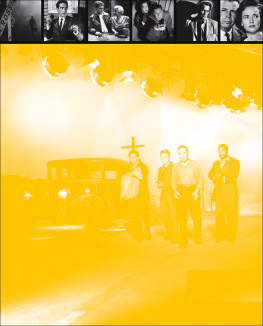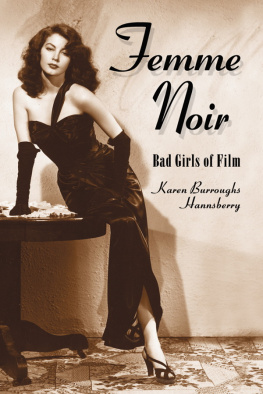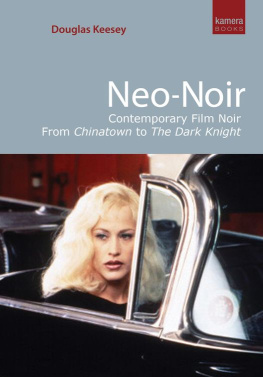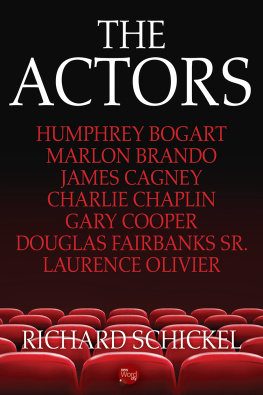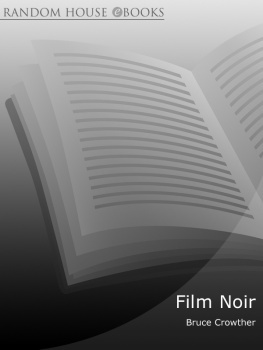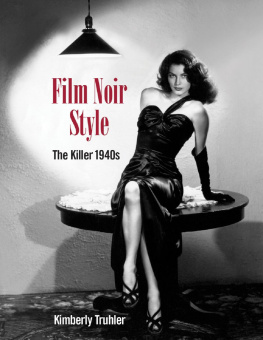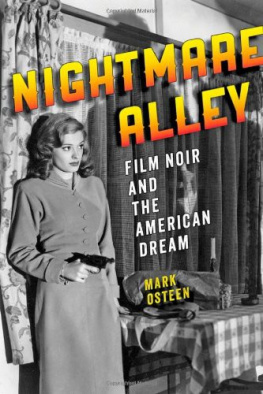BAD BOYS
A LSO BY KAREN BURROUGHS HANNSBERRY
AND FROM MCFARLAND
Femme Noir: Bad Girls of Film (1998; paperback 2010)
BAD BOYS
The Actors
of Film Noir
KAREN BURROUGHS
HANNSBERRY
(Acknowledgments; Preface; AdlerLovejoy)

McFarland & Company, Inc., Publishers
Jefferson, North Carolina, and London
LIBRARY OF CONGRESS CATALOGUING-IN-PUBLICATION DATA
BRITISH LIBRARY CATALOGUING DATA ARE AVAILABLE
ISBN 978-1-4766-0483-1
2003 Karen Burroughs Hannsberry. All rights reserved
No part of this book may be reproduced or transmitted in any form or by any means, electronic or mechanical, including photocopying or recording, or by any information storage and retrieval system, without permission in writing from the publisher.
On the cover: James Cagney
McFarland & Company, Inc., Publishers
Box 611, Jefferson, North Carolina 28640
www.mcfarlandpub.com
For all those I love, and all of those who love me.
ACKNOWLEDGMENTS
There are so many individuals without whom this book truly could not have been completed.
For their roles in helping to make my accounts of the actors in this volume come alive, I am most humbly grateful to Ed Begley, Jr., Jay Bernstein, Andrea Bershad (daughter of Sheldon Leonard), the late Jeff Corey, Kirk Douglas, Peter Ford (son of Glenn Ford), Farley Granger, Coleen Gray, June Lockhart, Michael Macready (son of George Macready), and Robert Wise.
I cannot find the words to express my appreciation for my tireless research assistants, Alan David Burroughs and Diane Sippl, who served as my eyes, heart, and mind on the East and West coasts. I am also indebted to Theresa Henderson Burroughs, who provided invaluable aid in countless ways, including compiling the index for this book. For their various forms of support and assistance, it is a pleasure to thank Evelyn Mildred Henderson, Veronica and Jessica Hannsberry, Imani Walton, Kevin Hamilton Smith, Bob King of Classic Images and Films of the Golden Age, James J.J. Wilson of Filmfax, Karin Dagneau, Evelin Past, Jane Kellogg, DeeDee E. Dellos, David Lee Guss, Judy Walters, Billy Long, Bob J. Robison, Jack Harnedy, Alvin Peterson, Adam Zanders, Ismaila Goudiaby, Keith Rogers, Alan K. Rode, Diane Karg, Janet Lorenz of the Margaret Herrick Library of the Academy of Motion Picture Arts and Sciences, the staff of the performing arts section of the Harold Washington Library in Chicago, and the staff of the Library of the Performing Arts in New York.
For assisting me in securing the striking photographs that provide a visual depiction of noirs bad boys, I express sincere gratitude to Ron Harvey and Bruce Donnella of the Everett Collection in New York City; Jim Shepard of the Collectors Bookstore in Hollywood, California; Movie Star News in New York City; T. Gene Hatcher; and David Wentick.
Finally, for helping me to obtain the hundreds of films in which it was a pleasure and privilege to lose myself during countless hours, I am truly indebted to Nick Lapetina, Dan Van Neste, and Marc Dolezal.
CONTENTS
PREFACE
All rightIve been a bad boy.Bruce Bennett in Nora Prentiss (1947)
He hails from the dark side of the screen.
He can be vicious or violent, as likely to slap a dames face as kiss her. Or a dauntless protector of the law, nabbing hoods with a combination of instinct, fortitude, and grit. He might be vulnerable and gullible, apt to succumb to the whims of a conniving cutie at the drop of the proverbial hat. He can be inexorably hardened by lifes unforeseen knocks, brimming with cynicism, suspicion, and doubt. Or overcome with desperate disillusionment, caught up in circumstances beyond his control and urgently seeking a way out of a seemingly hopeless plight.
More so than his feminine counterpart, this man represents every type of persona, occupying all social and economic strata, and spanning the occupational gamut from the vilest petty criminal to the most upstanding judge. He is an indefatigable gumshoe in The Big Sleep (1946), a carnival sharpshooter in Gun Crazy (1949), an unscrupulous newspaper photographer in Shakedown (1950), a hard-working truck driver in Desperate (1947), a prize-fighter in The Set-Up (1949), a priest in Edge of Doom (1950). He pumps gas in The Postman Always Rings Twice (1946), sells insurance in Double Indemnity (1944), drives a taxicab in 99 River Street (1953), writes short stories in Danger Signal (1945), picks pockets in Pickup on South Street (1953). He is an endless number of syndicate chiefs, assistant district attorneys, private dicks, gun-toting henchmen, and prison inmates.
He dwells in the world of the film noir.
From Philip Marlowe and Sam Spade to Johnny Rocco and Cody Jarrett, the film noir male is a unique, fascinating, and infinitely watchable being, displaying a wide range of emotions, behaviors, and motivations. Some of the films from the era depict men who are almost mindlessly violent, such as Neville Brands Chester in D.O.A. (1950), whose sole enjoyment in life seems to be derived from inflicting pain on others. Other films noirs contain flawed authority figures, as in The Glass Key (1942), in which Senator Ralph Henry (Moroni Olsen) conceals his role in his sons death; Guilty Bystander (1950), which features alcoholic ex-cop Max Thursday (Zachary Scott); or Detective Story (1951), where law man Jim McLeod (Kirk Douglas) is ruled by an inflexible moral code that costs him his marriage and, ultimately, his life. Some focus on hapless males whose lives are turned upside down because of their unquenchable desire for a woman, such as insurance agent John Forbes (Dick Powell) in Pitfall (1948), garage mechanic Dan Brady (Mickey Rooney) in Quicksand (1950), or Mike Lambert (Glenn Ford), the unemployed engineer in Framed (1947). Then there are films in which ruthless, powerful crime bosses rule with a steel will and an iron fist, including the brutal Mr. Brown (Richard Conte) in The Big Combo (1955) and Neil Eichelberger (Ed Begley) in The Turning Point (1952), who sacrifices a building of innocent people in the pursuit of his personal objectives. And on the right side of the law, film noir offers numerous portraits of courageous officers, from undercover agents such as Lawrence Trumble (William Bendix) in Macao (1952), to beat cops including Rocky Barnes (Mark Stevens) in Between Midnight and Dawn (1950). From the most imposing gumshoe to the meekest elevator operator, each man in film noir plays a role in weaving the fabric of this dim and murky universe.
The poor boyhes psychopathic. He likes the sight of blood.Luther Adler in D.O.A. (1950)
The era of film noir is one that disdains absolute definitions, flaunts exceptions, and welcomes interpretations. The movies that comprise this category of filmmaking were released approximately between 1940 and 1959, but were first identified as film noir (literally, black film) in 1946 by French critics who became aware of a dark, cynical tone that was prevalent in a growing number of American motion pictures. As I wrote in my previous book, Femme Noir: Bad Girls of Film, these films depict a world of pessimism, corruption, and hopelessness, and are distinguished by their shadowy, dim appearance and dark overtones. These films also commonly contain specific elements of plot, setting, and characterization, including urban locales, the commission of crimes, the presence of femmes fatales, betrayal between characters, and the use of flashback and narration. In addition, films noirs frequently include such visual details as dimly lit rooms, unusual camera angles, and rain-slick streets.
Next page

